We’ve gone all-in with our smoker this year, and today’s Smoked Salmon is one of the best foods to emerge from the grates. This easy recipe is appropriate for beginners, can be used on any style of smoker, and it includes helpful tips so that even first-timers can create smoky, succulent salmon with success.

Email Me the Recipe!
From time to time, we'll send you Well Plated emails. You can unsubscribe anytime. Have an account? Log In.
An easy smoked salmon recipe for cooks of all levels.

This post will walk you through the easiest way to cook smoked salmon on an outdoor smoker. You can do this!
From choosing and seasoning your salmon, to prepping your smoker, to ways to serve it—I’ve got you covered.
You can use this recipe on any style of smoker, including charcoal smokers (Weber, Big Green Egg), pellet smokers (Traeger), and electric smokers.
First, let’s clarify the type of smoked salmon we are making: hot-smoked salmon.
- Hot Smoked Salmon is smoked at a higher temperature (around 150°F to 170°F, though you can go up to 200°F with great results) for a shorter amount of time—1 1/2 to 3 hours for a large (3-to 4-pound) side of salmon. Hot smoked salmon is flaky and buttery with a pronounced smoky flavor.
- Cold Smoked Salmon is smoked at a lower temperature (around 80°F) for a longer period (12-24 hours). Cold smoked salmon is firm, with a mild smoky flavor.
You can absolutely chill hot smoked salmon and serve it cold. It’s delicious either way!
5 Star Review
“Absolutely fantastic! Took a risk making it for the first time for a dinner party and was not disappointed. The Dijon and dill made it so good!”
— Owen —

What You’ll Need to Make Smoked Salmon
The full ingredient list is in the recipe card at the bottom of the page, but here’s a list of the equipment and ingredients you’ll need.
Equipment
- Charcoal. Charcoal users will need their charcoal to build a fire; if using a pellet or electric smoker, you don’t need to worry about this.
- Wood Chips (or Wood Pellets). The best woods for smoking salmon are fruit woods like apple, or a mild wood like alder or oak. Do not use mesquite, which can overpower fish.
- Instant Read Thermometer. The true, best way to know when salmon is done. If you’re going to be smoking, it’s an essential. In smokers especially, cooking time can vary widely. The best, truest way to know your salmon is done is by temperature.
Ingredients
- Center-Cut Side of Salmon. This large cut is taken from the middle of the fish. It has a relatively uniform thickness, making it ideal for smoking because it cooks evenly.
- Dijon. Tangy Dijon mustard pairs beautifully with salmon and the other flavors in this recipe.
- Honey. A little sweet to balance the smokiness. Along with the mustard, the honey helps the smoky flavor stick to the salmon.
- Salt + Pepper. Simple, classic, must-have seasonings.
- Paprika. Slightly sweet paprika thrives alongside the smoky flavors.
- Dill. Adding dill is a tip I picked up from my brother-in-law. It’s fresh, delicious, and complements the salmon so well.

Making Your Salmon Delicious (+ A Note About Pellicle)
Many traditional recipes call for brining the salmon, then air drying it for several hours prior to smoking in order to form a thin, dry surface on the outside called the pellicle.
The purpose of the pellicle is to create a tacky surface so the smoke’s flavor has something to cling to as the salmon cooks.
I found that coating the salmon with a sticky substance (honey) served the same purpose, and the pellicle wasn’t necessary.
Skipping the brining and pellicle saves hours, meaning you can be enjoying your salmon sooner rather than later!

How Long to Cook Smoked Salmon
This can vary based on many factors: the type of salmon you choose (farm raised is fattier and thus takes longer than wild-caught), what smoker you have, the temperature inside your smoker, how consistently your smoker retains heat…even the weather!
For this reason, judge by the temperature on your thermometer, not the time on the clock.
While salmon should always be cooked to temperature, not time, you can estimate the following windows.
- 3- to 4-pound side of salmon. 2 to 3 hours at 200 degrees F.
- 1- to 2-pound side of salmon. 45 minutes (for a small, 1-pound side) to 2 hours at 200 degrees F.
If your salmon is larger or smaller, or your smoker is hotter or colder, you will need to add or subtract time accordingly.
The FDA advises to cook salmon to 145 degrees F. However, the salmon’s temperature will rise as it rests.
- If you cook the salmon all the way to 145 degrees F, your salmon will be dry.
- For this reason, I recommend removing the salmon from the smoker when it reaches 135 degrees F for medium salmon.
- For medium-rare salmon, remove at 130 degrees F.

How to Make Smoked Salmon
This recipe comes together in 4 steps:
- Heat Your Smoker. 200 degrees F is easy to maintain on any kind of smoker (keeping a fire lower than this is challenging on a charcoal smoker).
- Trim the Salmon (if needed). If the salmon still has the belly (thin white strip that runs up the side) and thin tail piece attached, trim these off so the salmon smokes evenly.


- Season and Slather to Make It “Sticky”. Pat the salmon dry. Slather the salmon with honey and Dijon to act as the “pellicle.” Then, sprinkle it with your seasonings of choice.
- Smoke the Salmon to Temperature. Remember, although the FDA considers 145 degrees F “done,” the salmon’s temperature will rise as it rests, so remove it early—130 to 135 degrees F. At the 30-minute mark (for smaller pieces) or 45-minute mark (for larger pieces), give the salmon a temperature check so you can gauge how quickly it is progressing.

Ways to Eat Smoked Salmon
Smoked salmon is delicious whether you enjoy it on its own or as a part of a recipe. Here are a few ways you can serve it:
- Bagel. Top a bagel with cream cheese, capers, and smoked salmon. YUM!
- Salad. For a hearty, healthy salad, combine mixed greens, tomatoes, avocado, and smoked salmon. Swap it for the chicken in Cobb Salad or use in place of tuna for a Nicoise Salad.
- Pizza. Smoked salmon can be a delicious pizza topping with cream cheese “sauce” and onions (especially red onion). Use my Whole Wheat Pizza Dough for the crust or store bought options like Naan Pizza.
- Dip. Smoked Salmon Dip is absolutely delightful and always a crowd-pleaser.
- Pasta. We already know salmon and pasta are a dream team (thanks to Salmon Pasta), but smoked salmon takes things to an entirely new level. Try adding it to this Pasta al Limone.
- Sandwich or Wrap. Wrap smoked salmon in a tortilla or add it to a slice of Oatmeal Bread with cream cheese, lettuce, and tomato.
- Eggs. Smoked salmon with eggs is a scrumptious meal. You could even add it to a Potato Frittata.
Leftover Ideas
The possibilities for leftover smoked salmon are endless. One of our favorite ways to enjoy it is flaked into some Homemade Fried Rice.

Smoked Salmon
Email Me the Recipe!
From time to time, we’ll send you Well Plated emails. You can unsubscribe anytime. Have an account? Log In.
Ingredients
- 2- to 3- pound center-cut side of salmon skin-on with pin bones removed*
- 1 ½ tablespoons Dijon mustard or additional honey
- 1 ½ tablespoon honey or maple syrup
- 1 tablespoon paprika
- 1 ½ teaspoons kosher salt DO NOT use table salt; (I use Morton’s Kosher)
- ¾ teaspoon freshly ground black pepper
- 1 cup loosely packed, chopped fresh dill about 1 bunch (optional)
- Charcoal pellets, or whatever fuels your smoker
- 2 handfuls wood chips such as apple, cherry, oak, or alder (do not use mesquite which can overpower fish)
- Canola oil to prevent sticking
Instructions
- Trim the salmon (if necessary).

- Remove the salmon from the refrigerator and let come to room temperature. Pat the salmon very dry on both sides. Place the salmon on a parchment-lined baking sheet or similar surface to where you can carry it out to the smoker easily.

- Heat your smoker nice and low—150 to 170°F is ideal, but can be difficult to maintain; 200°F is attainable, what we use, and will give you delicious results. On our kamado smoker (Green Egg) the fire is very small (see photo above). Add 2 handfuls of wood chips in with your charcoal prior to lighting (I do not soak mine first).

- Brush the salmon all over with the Dijon mustard and honey. (These act like the pellicle, the sticky layer that allows the smoke flavor to adhere).

- In a small bowl, stir together the paprika, salt, and pepper. Scatter all over the top of the salmon.

- Top with fresh dill, sprinkling it all over the salmon.

- Liberally brush the smoker grates with oil. Place the salmon on the smoker. Cover and cook until the salmon reaches 135°F (for medium to medium-rare salmon) or up to 145°F (for well-done salmon; note the temperature will continue to rise as it rests). The total time your salmon needs to smoke will vary based on A LOT of factors: its thickness, if it's wild-caught vs. farmed (farmed salmon has a higher fat content and takes longer), how much your smoker temperature fluctuates, and how hot the smoker is—plan on 1 hour to 1 hour 15 minutes for a 2-pound fillet at 200°F. Decide when to take the salmon off the smoker based on its temperature, not the time on the clock. If cooking a smaller fillet (1 to 1 1/2 pounds), check in at the 40-minute mark to gauge its progress.

- Let the salmon rest a few minutes. Enjoy hot or room temperature, or to serve cold, let cool to room temperature, wrap tightly, and refrigerate until completely chilled.

Notes
- *A center-cut fillet is cut so that it is shaped somewhat like a rough rectangle—the skinniest part of the tail end of the salmon and the salmon belly (the thin white strip that runs down the side of the fillet) are both trimmed away. You can purchase the salmon already cut, or easily trim it at home (reserve the tail and belly and cook separately). If you are purchasing a piece of salmon with the belly and tail still attached, be sure to buy a bit more than the weight you want to smoke, since you’ll be trimming some away. The seasoning measurements listed are flexible and designed for a 2 1/2-pound side, so feel free to scale up or down depending on the size of your fish.
- Smoked salmon vs. Gravlax vs. Lox: Lox and Gravlax are both cured in salt and not smoked. Unlike Lox, the brine for Gravlax typically includes sugar and dill. Smoked salmon is the only variety that is smoked.
- What’s That White Stuff? That white stuff you’re seeing is called albumin. It’s a protein from the salmon that can congeal during cooking, and it’s completely safe. If you don’t enjoy the look of it, feel free to scrape it off.
- TO STORE: Tightly wrap salmon in plastic wrap and refrigerate in an airtight storage container for up to 4 days.
- TO REHEAT: If you’d like to serve your salmon warm, very gently reheat it in a skillet over low heat.
- TO FREEZE: Tightly wrap smoked salmon and freeze it in an airtight freezer-safe storage container for up to 3 months. Let thaw overnight in the refrigerator before reheating.
Nutrition
Email Me the Recipe!
From time to time, we’ll send you Well Plated emails. You can unsubscribe anytime. Have an account? Log In.
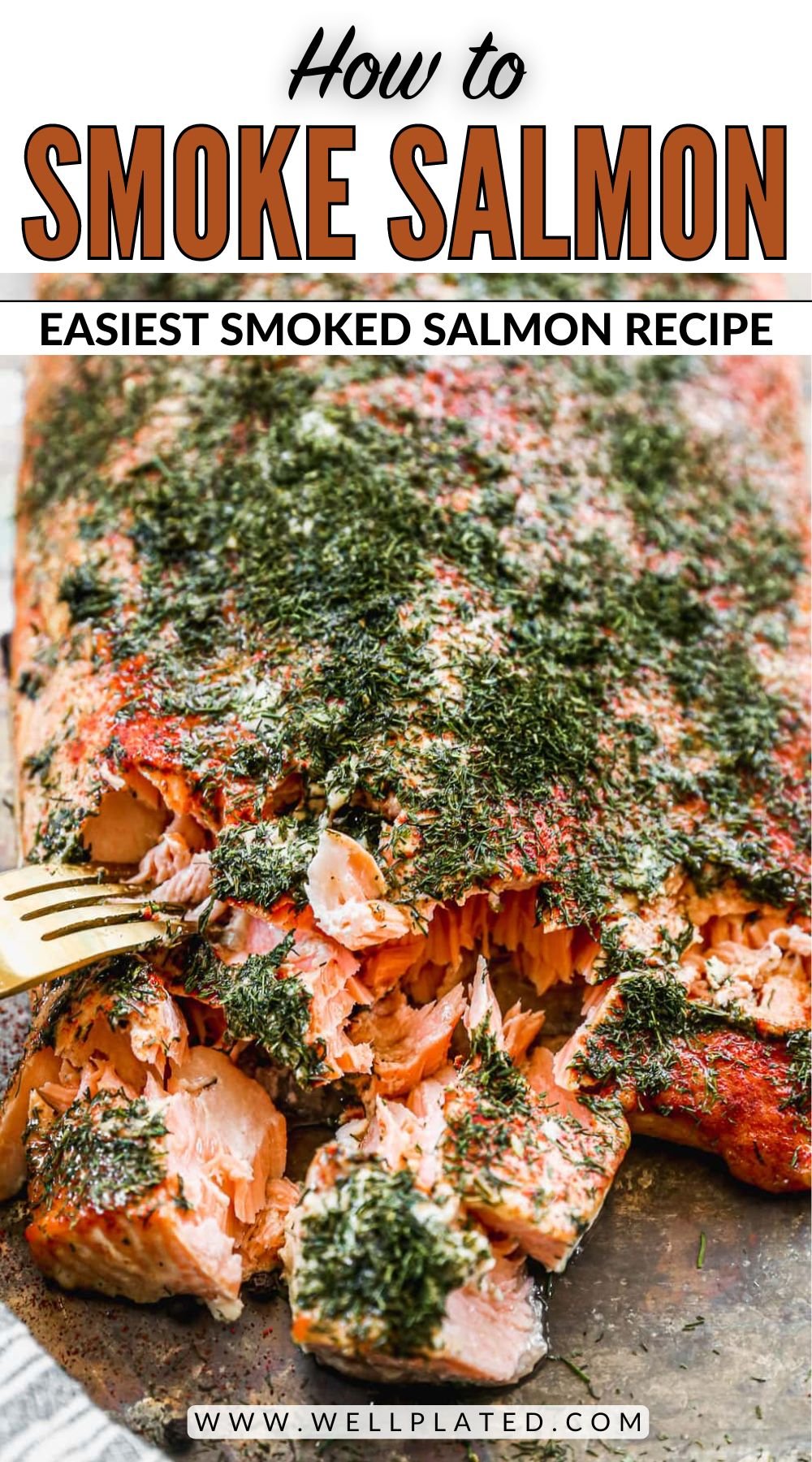
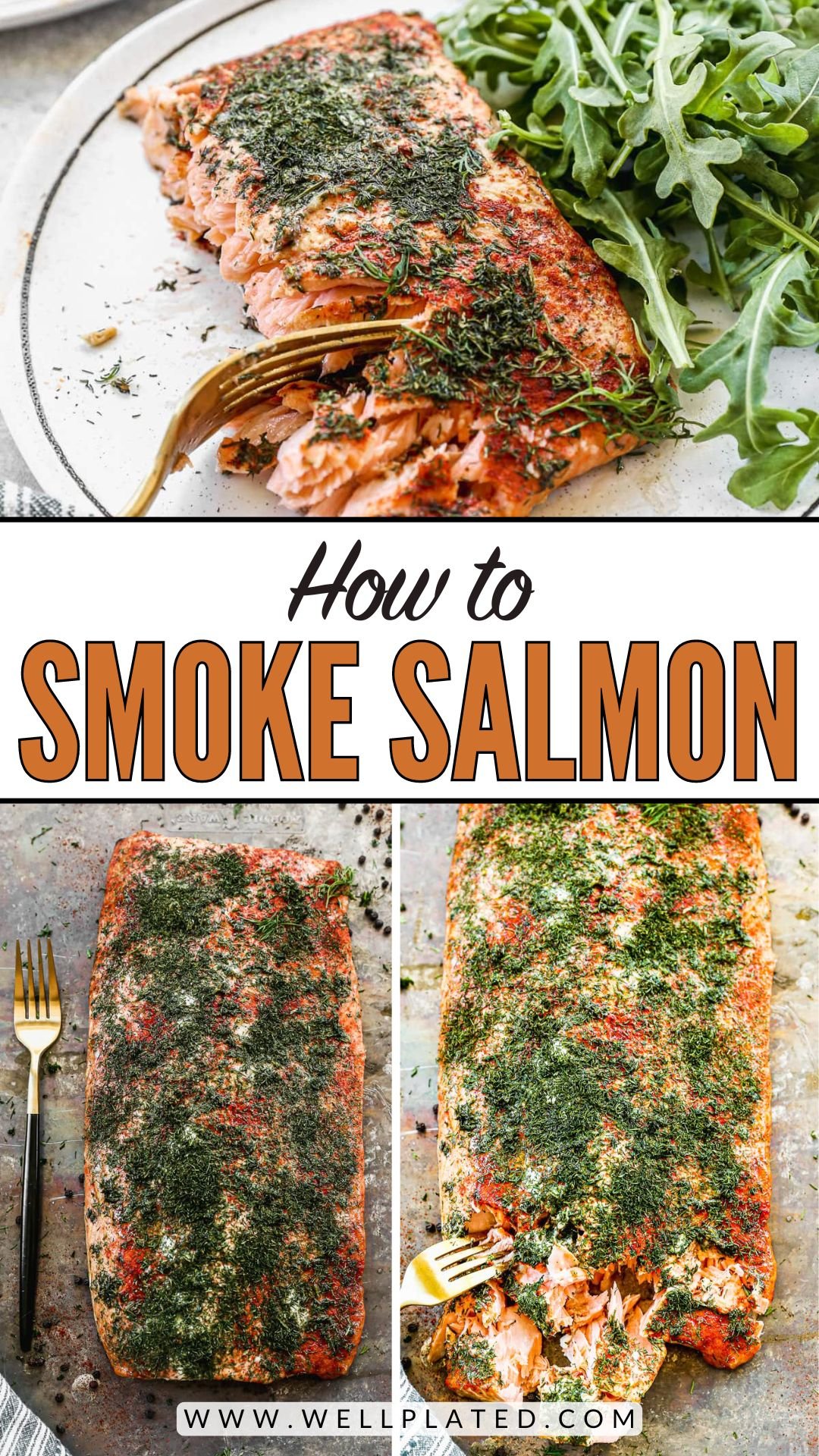
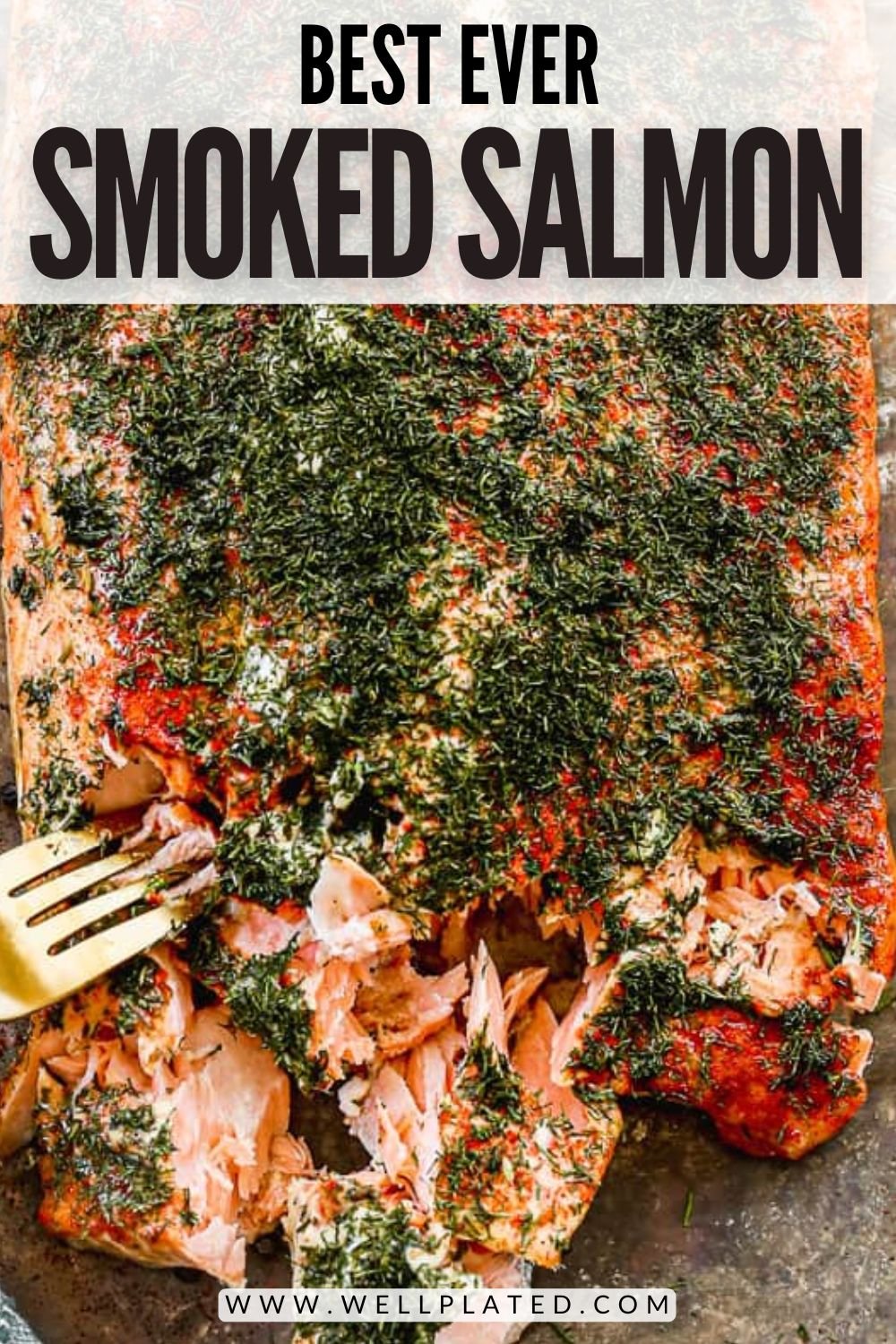









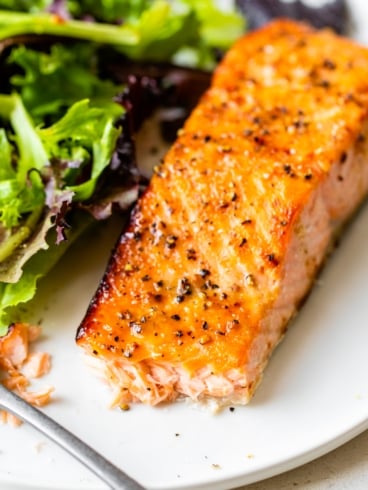
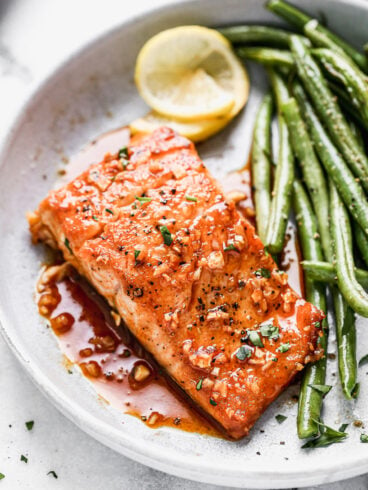


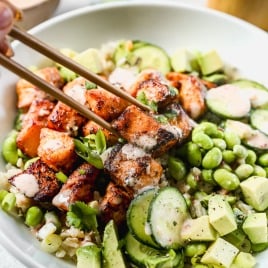

absolutely fantastic! Took a risk making it for the first time for a dinner party and was not disappointed. The Dijon and dill made it to good!
Hi Owen! So glad you enjoyed the recipe! Thank you for this kind review!
Cut the salt I half or more.
Renee, did you try this as is and find it too salty? Or do you mean generally based on reading the recipe?
This was awesome! I should learn to read the whole recipe before starting as I did add the seasoning to the dijon / honey mix but turned out great. I also added a couple of cloves of garlic, but the dijon & honey mix was wonderful! Family loved it – I will make this again!
Glad it worked out, Geri! Thank you!
Best smoked salmon we’ve ever had! We cooked on our weber and it was so moist and flavorful with the right amount of smoke. We didn’t have applewood, but I want to try it for next time
Yay! Glad you enjoyed it, Monica!
Our whole family enjoyed the entree. The temperature hit a stall point however and the smoking process took around an hour longer than expected with a 3# salmon. We used a gas grill and monitored both the grill and salmon temperatures closely thought the cooking process.
Thanks for the feedback, Laurie! Glad you enjoyed it!